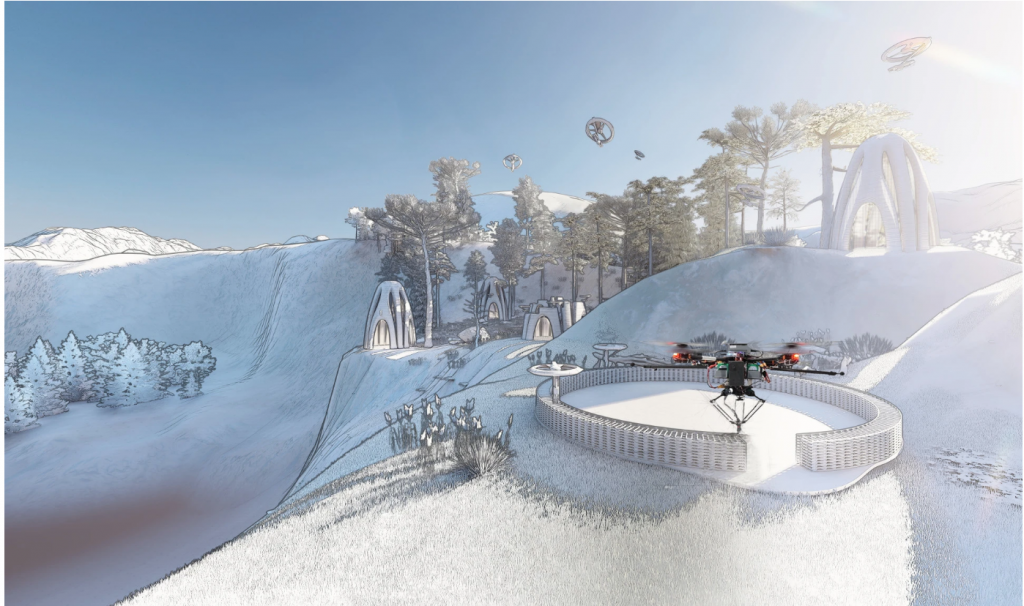
Illustration of drones building in a remote area. (Source: Imperial College London)
TechCrunch Introduces AI Column to Zero in on Barrage of New Discoveries, Tech Offerings
The AI universe is growing and advancing so fast any more it is difficult to keep up with the latest miracle that AI performs. Also, using AI to train AI has speeded up developments exponentially. One of the better sources for AI news is techcrunch.com, which introduced a new column called Perceptron. Juicy with new information from across the AI spectrum, it has several components to keep readers abreast of new developments
Today we are going to touch on just a couple of the reveals from the new column and tease you into reading it in its entirety:
Perceptron
Research in the field of machine learning and AI, now a key technology in practically every industry and company, is far too voluminous for anyone to read it all. This column, Perceptron, aims to collect some of the most relevant recent discoveries and papers — particularly in, but not limited to, AI — and explain why they matter.
Up first, an AI system Google has named PaLI.
Over the past few weeks, researchers at Google have demoed an AI system, PaLI, that can perform many tasks in over 100 languages. Elsewhere, a Berlin-based group launched a project called Source+ that’s designed as a way of allowing artists, including visual artists, musicians, and writers, to opt into — and out of — allowing their work to be used as training data for AI.
AI systems like OpenAI’s GPT-3 can generate fairly sensical text, or summarize existing text from the web, e-books, and other sources of information. But they’ve historically been limited to a single language, limiting both their usefulness and reach.
Google claims that PaLI can understand 109 languages and the relationships between words in those languages and images, enabling it to — for example — caption a picture of a postcard in French. While the work remains firmly in the research phases, the creators say that it illustrates the important interplay between language and images — and could establish a foundation for a commercial product down the line.
DeepMind
Now we are aware that much of this article is deeper than the average computer operator has to delve into to do their job. However, this is just a sampling of the newer aspects of AI that will eventually reach and touch your life in one way or another. It’s best to at least be familiar with what is out there.
Over at DeepMind, a research team is attempting to solve another longstanding problematic aspect of AI: its tendency to spew toxic and misleading information. Focusing on text, the team developed a chatbot called Sparrow that can answer common questions by searching the web using Google. Other cutting-edge systems like Google’s LaMDA can do the same, but DeepMind claims that Sparrow provides plausible, non-toxic answers to questions more often than its counterparts.
The trick was aligning the system with people’s expectations of it. DeepMind recruited people to use Sparrow and then had them provide feedback to train a model of how useful the answers were, showing participants multiple answers to the same question and asking them which answer they liked the most.
The researchers also defined rules for Sparrow such as “don’t make threatening statements” and “don’t make hateful or insulting comments,” which they had participants impose on the system by trying to trick it into breaking the rules.
DeepMind acknowledges that Sparrow has room for improvement. But in a study, the team found the chatbot provided a “plausible” answer supported with evidence 78% of the time when asked a factual question and only broke the aforementioned rules 8% of the time.
Nvidia
Once again this amazing tech company is having huge success releasing new products chockfull of new algorithms.
Nvidia had a field day on September 20 of this year announcing dozens of products and services, among them several interesting AI efforts. Self-driving cars are one of the company’s foci, both powering the AI and training it. For the latter, simulators are crucial and it is likewise important that the virtual roads resemble real ones. They describe a new, improved content flow that accelerates bringing data collected by cameras and sensors on real cars into the digital realm
There is a great deal more information about NVIDIA’s AI-driven product explosion on the Perceptron list of the latest in AI. The column has videos, incredible images from the new generators and much more, The link below will allow you to take a peek at Perceptron.
The last thing today is a drone-based 3D printing technique from Imperial College London that could be used for autonomous building processes sometime in the deep future.
read more at techcrunch.com







Leave A Comment